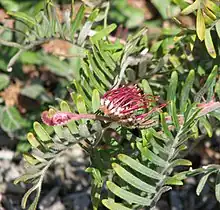Grevillea caleyi
Grevillea caleyi, also known as Caley's grevillea, is a species of flowering plant in the family Proteaceae and is endemic to a restricted area of New South Wales. It is an open, spreading shrub with deeply divided leaves with linear lobes, and fawn flowers with a maroon to red style.
| Caley's grevillea | |
|---|---|
 | |
| In Royal Botanic Gardens, Cranbourne | |
| Scientific classification | |
| Kingdom: | Plantae |
| Clade: | Tracheophytes |
| Clade: | Angiosperms |
| Clade: | Eudicots |
| Order: | Proteales |
| Family: | Proteaceae |
| Genus: | Grevillea |
| Species: | G. caleyi |
| Binomial name | |
| Grevillea caleyi | |
| Synonyms[1] | |
Description
Grevillea caleyi is an open, spreading shrub that typically grows to 1–4 m (3 ft 3 in – 13 ft 1 in) and wide. It has deeply divided leaves 70–180 mm (2.8–7.1 in) long and 30–75 mm (1.2–3.0 in) wide with linear to lance-shaped lobes, the narrower end towards the base, the lobes 15–35 mm (0.59–1.38 in) long, 2–6 mm (0.079–0.236 in) wide with the edges turned downwards, and hairy on the lower surface. The flowers are arranged in toothbrush-like groups on a rachis 40–80 mm (1.6–3.1 in) long, and are fawn with a maroon to red style with a green tip. The pistil is 25–28 mm (0.98–1.10 in) long and the style is glabrous. Flowering mostly occurs from August to December and the fruit is a woolly hairy follicle 17–21 mm (0.67–0.83 in) long.[2][3][4]
Taxonomy
Grevillea caleyi was first formally described in 1830 by Robert Brown in Supplementum primum prodromi florae Novae Hollandiae from specimens collected in 1805, near Port Jackson by George Caley.[5][6] The species has the common name Caley's grevillea.[7]
Distribution and habitat
Caley's grevillea grows in woodland on sandstone ridgetops in the Terrey Hills-Belrose area in the north of Sydney.[3][8]
Conservation status
This grevillea is listed as "critically endangered" under the Australian Government Environment Protection and Biodiversity Conservation Act 1999 and the New South Wales Government Biodiversity Conservation Act 2016. The main threats to the species include habitat loss and fragmentation, inappropriate fire regimes, recreation activities and rubbish dumping.[3][7][8]
References
- "Grevillea caleyi". Australian Plant Census. Retrieved 7 February 2022.
- Makinson, Robert O. "Grevillea caleyi". Australian Biological Resources Study, Department of Agriculture, Water and the Environment. Retrieved 8 February 2022.
- Makinson, Robert O. "Gravillea caleyi". Royal Botanic Garden Sydney. Retrieved 24 December 2021.
- Wood, Betty. "Grevillea caleyi". Lucid Keys. Retrieved 7 February 2022.
- "Grevillea caleyi". APNI. Retrieved 8 February 2022.
- Brown, Robert (1830). Supplementum primum prodromi florae Novae Hollandiae. London. p. 22. Retrieved 7 February 2022.
- "Conservation Advice Grevillea caleyi (Caley's grevillea)" (PDF). Australian Government Department of Agriculture, Water and theEnvironment. Retrieved 7 February 2022.
- "Caley's grevillea - profile". New South Wales Government Office of Environment and Heritage. Retrieved 8 February 2022.
